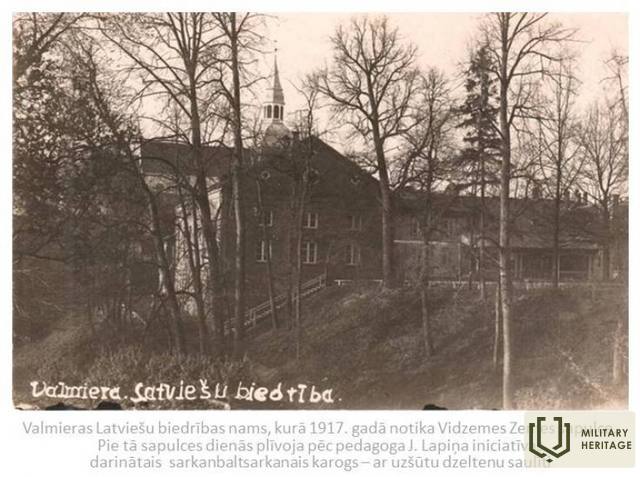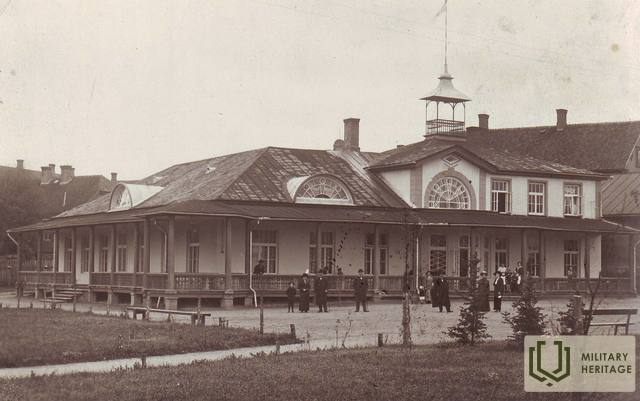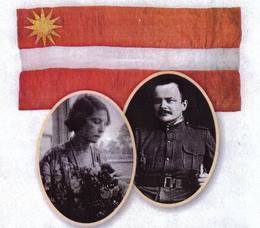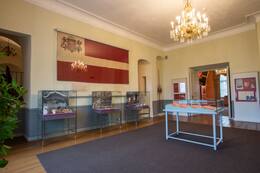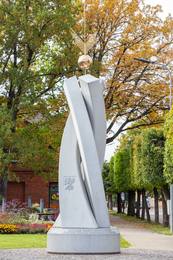März 1917 – ein wichtiger Monat in der Geschichte von Valmiera und Lettland
Im März 1917, mehr als ein Jahr vor der Ausrufung des Staates Lettland, wurde in Valmiera der Provisorische Landrat von Vidzeme gegründet, der eine Resolution zu den Autonomie- und Selbstbestimmungsrechten Lettlands verabschiedete. Am Tag der Gründung des Rates wurde am Versammlungsort erstmals die rot-weiß-rote Flagge gehisst.
Am 12. und 13. März (25. und 26. März) 1917 fand die Landversammlung von Vidzeme statt. Vertreter der lokalen Regierungen, Genossenschaften, landwirtschaftlichen Vereine und Landlose aus den Bezirken Riga, Cēsis, Valmiera und Valka versammelten sich in Valmiera. Obwohl die Tagesordnung sowohl politische als auch wirtschaftliche Fragen umfasste, bestand die eigentliche Aufgabe der Versammlung in der Gründung des Provisorischen Landrats von Vidzeme. Der Agronom Kārlis Ulmanis, Hauptredner, betonte die künftig anzustrebenden politischen Ziele. Es wurden 17 Resolutionen verabschiedet, die wichtigste davon betraf die Autonomie- und Selbstbestimmungsrechte Lettlands.
Knapp zwei Jahre später, am Abend des 17. November 1918, wurde im Suworow-Hotel in Riga der Lettische Volksrat gegründet und Kārlis Ulmanis zum Ministerpräsidenten der Provisorischen Regierung Lettlands gewählt. Der Volksrat beschloss, die Ausrufung des Lettischen Staates im Lettischen Opernhaus (heute Lettisches Nationaltheater) zu vollziehen.
Bereits am nächsten Tag, dem 18. November 1918, bat Dr. Georgs Apinis in Valmiera die deutschen Besatzungsbehörden um Erlaubnis, eine Generalversammlung des Valmieraer Sportvereins im Pavillon des Alten Knabenparks abzuhalten. Apinis’ Mitarbeiter, die seine wahren Absichten kannten, hatten heimlich eine rot-weiß-rote Fahne anfertigen lassen, den Text „Gott segne Lettland“ darauf gedruckt und sie zum Pavillon gebracht. Dr. Apinis erläuterte den Anwesenden die historische Bedeutung dieses Tages, während die Teilnehmer feierlich gelobten, den neuen Staat und seine Provisorische Regierung unter Kārlis Ulmanis zu unterstützen. An diesem Tag wurde in Valmiera erstmals die Nationalflagge als Staatsflagge gehisst und die neue Nationalhymne „Gott segne Lettland“ zum ersten Mal gespielt.
Interessanterweise gehörten die Einwohner von Valmiera zu den Ersten, die von der Gründung des lettischen Staates erfuhren. Bereits am Vortag war die Nachricht auch an der Realschule Valmiera bekannt geworden, wie ein Eintrag im Tagebuch eines Schülers vom 18. November 1918 belegt: „Aufgrund der Ausrufung des lettischen Staates finden die letzten drei Unterrichtsstunden nicht statt.“ Am selben Tag posierten die Schüler der Realschule Valmiera vor dem Schulgebäude mit rot-weiß-roten Bändern für ein Gruppenfoto.
Quelle: Historische Abteilung des Valmiera-Museums
Zugehörige Zeitleiste
Zugehörige Themen
Zugehörige Objekte
Hirschpark und Konzerthalle "Valmiera"
Der Park befindet sich im Zentrum von Valmiera.
Im Jahr 1914 beschlossen acht unternehmungslustige Einwohner von Valmiera, am damaligen Stadtrand einen Park mit einem alkoholfreien Buffet und einem Büchertisch zu errichten – so begann die Geschichte des Vecpuiši-Parks.
Die Entwicklungsarbeiten im Park wurden durch den Ersten Weltkrieg unterbrochen.
Bereits zu Kriegsbeginn wurde im Pavillon ein Lazarett für verwundete Soldaten eingerichtet. Im zweiten Stock des Gebäudes befanden sich das Valmieraer Rotkreuzkomitee, dessen zentrale Spendenannahmestelle, und ein Lager.
Das Komitee von Valmiera war eines der aktivsten in Lettland. Im Oktober 1914 betreute es 33 Lazarette mit 375 Betten. Das Komitee sammelte Spenden für den Unterhalt der Lazarette und die Behandlung verwundeter Soldaten, für warme Bettwäsche und Reisekosten für Genesene, für die Verpflegung durchreisender Verwundeter und sandte außerdem Hilfsgüter direkt an die Front. Einer der engagiertesten Mitarbeiter des Rotkreuzkomitees bei der Spendenakquise war Kārlis Ulmanis (1877–1942), der später der erste Ministerpräsident des unabhängigen Lettlands wurde.
Die Geschichte der Gründung der legendären lettischen Schützenbataillone ist eng mit dem Vecpuiši-Park verbunden. Am 4. und 5. August 1915 war dort ein Freiwilligenrekrutierungskomitee tätig, und am 6. August wurden von hier aus junge Soldaten zur Ausbildung abgeholt. Später wurden auch immer wieder junge Männer aus Valmiera und Umgebung von hier aus als Soldaten rekrutiert. Während des Krieges fanden im Park außerdem verschiedene Kultur- und Wohltätigkeitsveranstaltungen statt, deren Erlöse vollständig den Kriegsopfern zugutekamen.
Am 18. November 1918 wurde in Valmiera zum ersten Mal die Nationalflagge als Staatsflagge gehisst und die neue Nationalhymne „Gott segne Lettland“ zum ersten Mal gespielt.
Während des Zweiten Weltkriegs beherbergte das Pavillongebäude im Vecpuiši-Park ein Lazarett, und Schützen wurden von dort in den Kampf gebracht. Während der sowjetischen Besatzung wurde der Park am 12. August 1940 durch Beschluss des Stadtrats von Valmiera in Komsomol-Park umbenannt.
Nach dem Zweiten Weltkrieg diente der von Architekt Freibergs entworfene Pavillon bis 1966 als Kulturzentrum und später als Sportschule. Ende der 1990er-Jahre (1998) wurde der Pavillon im Bachelor Park wieder in Betrieb genommen.
Die in den Räumlichkeiten des Restaurants „Vecpuisis“ ausgestellten Fotografien zeigen die Gründer des Parks.
Gedenkstätte für J. Lapiņš, den Schöpfer der ersten lettischen Flagge
Liegt in „Lejas Pintuļi“, Gemeinde Veselava, Gemeinde Priekuļi.
Ein Denkmal für Jānis Lapiņš, den Schöpfer der lettischen Flagge, ist zu sehen.
Die Entstehung der lettischen Nationalflagge erfolgte während des Ersten Weltkriegs. 1915, bei der Gestaltung der Flaggen der lettischen Schützenbataillone, schlugen verschiedene Künstler die Farben Rot, Weiß und Rot für die Flaggenentwürfe vor. Nach dem Entwurf des Pädagogen und Journalisten Jānis Lapiņš wurde die rot-weiß-rote Flagge in der zweiten Hälfte des Jahres 1916 von seiner Schülerin Marianna Straumane, einer Lehrerin im Flüchtlingslager Valmiera, angefertigt.
Dies ist die erste bekannte und tatsächlich hergestellte lettische Nationalflagge, die bis heute erhalten geblieben ist.
Im Jahr 2014 wurde in „Lejas Pintuļi“ der Gemeinde Veselava, Region Priekuļi, eine Gedenkstätte für den Autor der Vorflagge, Jānis Lapiņš, eröffnet.
Die erste bekannte authentische lettische Nationalflagge, die nach Russland geschmuggelt und während der sowjetischen und deutschen Besatzung sorgsam versteckt wurde, befindet sich heute im Geschichts- und Kunstmuseum von Cēsis . Sie wurde 1997 von der Tochter der Familie Poga gestiftet.
Ausstellungen des Stadtmuseums für Geschichte und Kunst im Neuen Schloss Cēsis
Das Stadtmuseum für Geschichte und Kunst Cēsis befindet sich im Zentrum der Altstadt im Neuen Schloss. Die Dauerausstellung des Museums widmet sich der Geschichte und präsentiert Schlossinterieur. Sie steht unter dem Motto „Cēsis als Symbol der Geschichte Lettlands“. Sie ist unterteilt in zwei Themenbereiche. Die Ausstellung „Die rot-weiß-rote Flagge in der Geschichte von Cēsis und Lettland“ zeigt die Entstehungsgeschichte der nationalen Fahne vom 13. Jahrhundert bis zur Bestätigung als staatliches Symbol - als Nationalflagge Lettlands im 20. Jahrhundert. Auch die Flaggen der lettischen Schützenregimenter und die traditionelle Nutzung der lettischen nationalen Farben während der Unabhängigkeitskämpfe werden thematisiert. Die Ausstellung „Cēsis und der lettische Freiheitskampf“ widmet sich der Gründung des Regiments Cēsis im Dezember 1918, dem gemeinsamen Kampf von Esten und Letten in der Schlacht von Cēsis (dt. Wenden) 1919, der Zeit, als Cēsis während der Bermontiade 1919 kurzzeitig faktisch die Hauptstadt Lettlands bildete, und der Geschichte des städtischen Siegesdenkmals. Im Escape-Room „Legenden der Schlacht von Cēsis“ müssen die Spielteilnehmer innerhalb einer Stunde durch Lösen von Rätseln, Erkennen von Zusammenhängen und Suche nach versteckten Gegenständen den Weg nach draußen finden. Am 8. Dezember 1918 wurde im Schloss von Cēsis, organisiert durch Oberleutnant Artūrs Jansons, eine der ersten Einheiten der lettischen Streitkräfte aufgestellt: die Kompanie Cēsis. Am 8. Dezember 1933 wurde am Neuen Schloss von Cēsis, wo sich seinerzeit das Hauptquartier des 8. Infanterieregiments Daugavpils und der Klub der Garnisonsoffiziere befanden, eine Gedenktafel zu Ehren der Kompanie enthüllt.
Denkmal „Widmung an den Lettischen Provisorischen Nationalrat“
Das Denkmal „Widmung an den Lettischen Provisorischen Nationalrat“ befindet sich in Valka an der Kreuzung der Straßen Rīgas und Raina (Adresse Raina Straße 9A).
Das Denkmal wurde am 2. Dezember 2017 im Rahmen des Programms zum hundertjährigen Bestehen Lettlands enthüllt und erinnert an die Sitzung des Lettischen Provisorischen Nationalrats im Jahr 1917.
Die Idee zum Ensemble stammt von der Bildhauerin Arta Dumpe, der Steinmetz ist Ivars Feldbergs, die architektonische Planung wurde vom Architekturbüro SIA "Architectural Office Vecumnieks & Bērziņi" durchgeführt.
Den Sockel des Denkmals bildet ein großer Mühlstein – ein Symbol für Leben, Zeit und Ereignisse. Die Namen der Vorstandsmitglieder der LPNP sind in seine Seiten eingraviert. Vom Mühlstein erheben sich, wie die Pfade des Schicksals, drei Regionen – Vidzeme, Kurzeme und Latgale – mit ihren historischen Wappen in den Himmel. Den Abschluss bildet der Stern von Bethlehem, der sich in die Sonne des neuen lettischen Staates verwandelt. Der lettische Dichter, Prosaautor und Politiker Kārlis Skalbe (1879–1945) schrieb: „Auch Lettland hatte sein eigenes Bethlehem, das kleine, arme Valka …“.
Das Denkmal für den Lettischen Provisorischen Nationalrat ist eine Art Schuldenrückzahlung an die Menschen, die 1917 in Valka unter Einsatz ihres Lebens, geleitet von Idealen, in einer nahezu unmöglichen Situation die Grundlagen des lettischen Staates legten.
Zu jener Zeit war Valka die Stadt mit der größten lettischen Bevölkerung im noch nicht von Deutschland besetzten Gebiet. Nach dem Fall von Riga wurde sie zum Zentrum des lettischen gesellschaftlichen, politischen und kulturellen Lebens. Hier versammelten sich all jene, die den Wunsch nach der Verwirklichung des Selbstbestimmungsrechts der lettischen Nation einte. Vom 29. November bis zum 2. Dezember 1917 (nach der neuen Bezeichnung) fand im Rathaus von Valka (heute Gebäude in der Kesk-Straße 11 in Valka) die erste Sitzung des Lettischen Provisorischen Nationalrats statt, an der Vertreter nahezu aller einflussreichen lettischen Organisationen und Parteien teilnahmen. Erstmals erklärten sie offiziell das Ziel ihrer Tätigkeit – die Schaffung eines unabhängigen Nationalstaates – und verabschiedeten eine Erklärung zur Gründung eines vereinten und autonomen Lettlands in den lettischen Bezirken Vidzeme, Kurzeme und Latgale.




